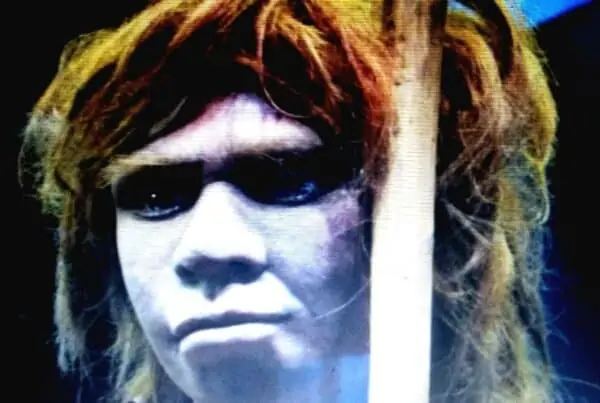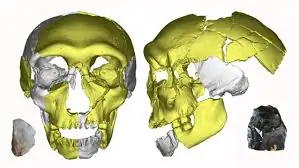Denisovans up to 6, 7% admixture in modern Asians, Melanesians, Papuans and isolated Filipino tribes
Denisovans were first discovered in 2008. A Russian archaeological team had been surveying the Denisovan cave in southern Siberia.
As archaeologist and genetics researcher Samantha Brown writing at ecoevocommunity.nature.com explains:
This site, located in the lowlands of the Altai Mountains in Russian Siberia, is unique in having evidence for three different hominin populations – Neanderthals, Denisovans, and modern humans. Stone tools are found throughout the cave alongside exceptional artefacts like bone needles and pendants.
The Russian team came across a curious fragment of a pinky bone that appeared to be Hominid.
From milnepublishing.geneseo.edu:
In 2008, Russian scientists Michael Shunkov (paleontologist) and Anatoly Derevianko (archaeologist) discovered a terminal finger phalanx from a young girl, dubbed “X-woman,” in the Denisova Cave in the Altai Mountains of Russia…
Naturally they believed it to be a Neanderthal and wanted confirmation. They relinquished the bone fragment to Svante Pääbo and his team of DNA researchers at the Max Plank Institute in Leipzig, Germany. Lab assistant Johannes Krause, well-known to regular readers of this site, sequenced the fragment. They didn’t fit with Neanderthal DNA sequences. Krause had discovered a new species of Hominid.
With agreement from the Russian team, the Hominid was dubbed “Denisovan” by Krause and Pääbo after the name of the cave in Siberia.
Two Denisovan teeth, and a skull bone fragment were found soon thereafter. And then a year later, a jawbone from another cave, 50 miles away was identified as Denisovan. Ironically, the jawbone had been sitting in a vault at a Chinese museum, unidentified for decades.
For years the entire inventory of Denisovan fossils consisted of these 5 fossils. But now the collection has been doubled in size.
“The big headline is certainly the 200 ka age of the fossils” — PhD student Samantha Brown
Samantha Brown, lead author of a new research paper out today, Tweeted out, Nov. 25:
We identified 5 new hominin remains at Denisova Cave! Included are three ~200,000 year old Denisovans, the earliest known fossils for this population so far.
D17 was the first hominin remain we found as part of the #FINDER project (finderc.org). This individual has Neanderthal mtDNA and originates from the same stratigraphic layer as Denny (the half Neanderthal, half Denisovan woman)
When we started working on the oldest archaeological layer for the East Chamber of Denisova Cave, the hominins started appearing surprisingly quickly. Here we found four new hominin remains, Denisovan mtDNA was extracted from three of them!
The research team included top names in paleo-anthropology and genetics such as Tom Higham and Katerina Douvka. They used a ground-breaking new technology to identify the 4 new Denisovan fossil fragments called ZooMS (Zooarchaeology by Mass Spectrometry). As Brown explains, they use “amino acid sequences of collagen to make taxonomic identifications.” It’s tedious. They had to sift through 250,000 fragments to find the jackpot of the 4 Denisovan and 1 Neanderthal bones.
Brown:
The moment you find a hominin bone is a pretty incredible one. After hours, days, weeks of sorting through the spectra of cows, deer, and horses you realise you’re studying the collagen of something very different.
And the newly released paper makes stunning news on another front: The research team has confirmed that Denisovans were the first of all Hominids to occupy the cave at 200,000 years ago, well before successive habitations by both Neanderthals and Homo sapiens.
From the synopsis, at Nature.com,
The earliest Denisovans and their cultural adaptation
Since the initial identification of the Denisovans a decade ago, only a handful of their physical remains have been discovered. Here we analysed ~3,800 non-diagnostic bone fragments using collagen peptide mass fingerprinting to locate new hominin remains from Denisova Cave (Siberia, Russia).
We identified five new hominin bones, four of which contained sufficient DNA for mitochondrial analysis. Three carry mitochondrial DNA of the Denisovan type and one was found to carry mtDNA of the Neanderthal type. The former come from the same archaeological layer near the base of the cave’s sequence and are the oldest securely dated evidence of Denisovans at 200 ka…
The combination of bone collagen fingerprinting and genetic analyses has so far more-than-doubled the number of hominin bones at Denisova Cave and has expanded our understanding of Denisovan and Neanderthal interactions…
The one fragment found for a Neanderthal of the five has been dated to ~134,000 years ago:
We estimated the molecular age of the mtDNA of the newly identified Neanderthal (Denisova 17) to be ~134 ka…
Subspecieist caught up with PhD student of the University of Tübingen, Samantha Brown (non-native English speaker). She gave us this quote:
“The big headline is certainly the 200 ka age of the fossils! There was already some fantastic DNA and archaeological evidence for their [them] being the first group at the site. It is particularly exciting to have the actual fossils now though too.”
“Genes for dark skin, hair, and eyes were present in the Denisovan genome and are present in modern Melanesians” — Michael Shunkov
And an intriguing note, the new evidence suggests Denisovans and Neanderthals were living side by side, or even together in the region for 150,000 years.
Although it is not possible to tell where these interbreeding events occurred, they provide evidence for potential cohabitation and frequent interactions between the two hominin groups from >200 ka (Denisova 2) until their disappearance from the Altai around 50 ka…
As Shunkov explained in his earlier paper, Denisovan DNA in modern humans, identifying Denisovan DNA is particularly important in establishing the uniqueness of various modern human populations:
Denisovans seem to have interbred with the first wave of AMH as they passed through southern Asia after leaving Africa. These humans already carried neandertal genes from having interbred with them… modern human populations that have descended from those early humans (i.e. indigenous Melanesians, Polynesians, Australians, and some Filipinos) carry 4.8% Denisovan genes, along with the mean of 2.5% neandertal genes that all Eurasians possess, meaning that a total of ~7% of their genes are derived from extinct hominins!
Genes for dark skin, hair, and eyes were present in the Denisovan genome and are present in modern Melanesians (Marshall 2013). This is fascinating from two perspectives. First, it is interesting that those ancestral characteristics survived in a modern population. Second, we now know something about what the Denisovans likely looked like. Wow!
See our article from Aug. on the Ayta Magbukon with the highest percentage of Denisovan DNA of any population in the world. And a special thank you to PhD student and lead researcher Samantha Brown for the exclusive quote.








I simply love your website always filled with interesting artivles.
amazing discovery, i am of the australian descent and was surprised to learn that our dna was found in these people so far from our homeland during that period.
I’m not sure why, but I had to approve your comment. That has never happened before. I don’t have to approve comments. I wonder if it’s because you live in Australia?